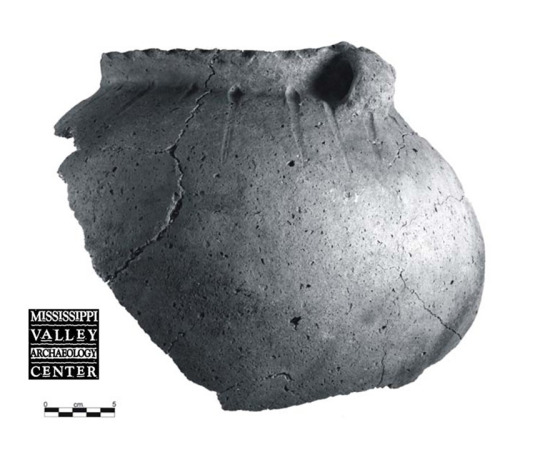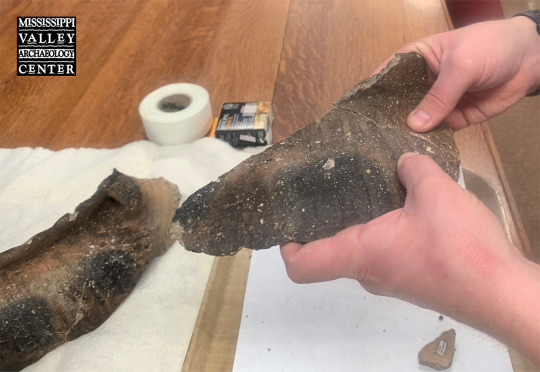#Pammel Creek Trailed
Photo

This large vessel section, called Vessel 108, was found in the early 2000s during excavations in the Sanford Archaeological District in La Crosse, Wisconsin. This late precontact Oneota site was inhabited during all three phases of the local Oneota occupation. Vessel designs and decorations provide clues to an Oneota vessel’s age. The rim of Vessel 108 has bold notching on the lip top to exterior lip, and the shoulder has a probable Pammel Creek Trailed motif of vertical finger trails. The trails begin at the top of the shoulder and are wide at the top, trailing off to nothing by the break in the shoulder. The vessel also has an undecorated strap handle attached just below the lip and a short rim height of 33.6 mm. The design and decoration—especially the bold impressions on the lip—are characteristic of the Pammel Creek phase (ca. AD 1400–1500), the middle phase of the Oneota occupation.
#archaeology#archeology#Oneota#ceramics#pottery#Oneota ceramics#Oneota pottery#Sanford Archaeological District#Pammel Creek Trailed
10 notes
·
View notes
Photo


Thanks to Wendy Holtz-Leith and Erik Anderson for this week’s post –
In 2012 MVAC excavated about 500 Oneota features exposed during the reconstruction of STH 35/2nd Avenue in downtown Onalaska. One unusual discovery was a nearly complete vessel found crushed in place at the base of a feature. Vessel 45, as it was later numbered, was represented by well over a hundred fragments of varying sizes.
Reconstructing a vessel is much like putting together a three-dimensional jigsaw puzzle, with quite a few pieces missing. You typically begin with the edges, which in the case of pottery, means the rim. Rim fragments from Vessel 45 were reassembled, and decorated body pieces were glued together and attached to the rim. Then came the slow process of figuring out where the undecorated pieces went. Some parts of the vessel were easier to figure out. Sherds from the base were thicker and in some cases larger, making it easier to fit them into place.
After most of the pieces were glued into larger sections, it was time to glue those sections together to form the whole vessel. This task was complicated by three things. First, some small joining fragments were missing. Second, errors in forming a vessel’s curved shape tend to creep in during the gluing and drying. Right after gluing, refitted pieces are usually placed in a sandbox to dry, and any shift can alter the curvature, making subsequent joins difficult. Third, the exterior had scorch marks or firing smudges that made its color quite variable—sometimes even adjacent sherds were completely different colors. In the end the vessel was fully reconstructed (albeit precariously), but it was left in a few very large segments because of those subtle errors from gluing.
The reconstructed vessel is very large and slightly oblong. It has a moderately high, slightly everted (outward-flaring) rim with bold finger impressions on the lip top to exterior lip. There are two handles on opposite sides of the vessel. The shoulder decoration consists of alternating panels of 12 or 13 vertical trails made with either a finger or a broad tool, and four nested chevrons with rectangular punctations below. There are four panels of nested chevrons, one under each handle and the others midway between them. The oblong rim has a diameter of 36.5 cm (14.4 inches) at the handles and ~34 cm (13.4 inches) midway between the handles. The motif is typical of the type Perrot Punctate, with very bold lip-top impressions typical of the Pammel Creek phase, A.D. 1400–1500.
#archaeology#archeology#Oneota pottery#pottery#Oneota ceramics#ceramics#Wendy Holtz-Leith#Erik Anderson#Pottery Reconstruction#Ceramic Reconstruction
17 notes
·
View notes
Photo

Vessel 29 was found at the base of an ash lens in an oval storage or refuse pit. This Koshkonong Bold variety bold vessel portion has a distinctive handle attached at the lip. The handle is a loop, flattened on both sides, with bold finger impressions that give it a wavy appearance. The finger impressions on the lip are also bold, as are the vertical finger trails on the shoulder. Vessel 29 was recovered during excavations in the early 2000s at the Sanford Archaeological District in La Crosse, Wisconsin. It probably dates to the Pammel Creek phase (A.D. 1400-1500) of the local Oneota occupation.
4 notes
·
View notes
Photo

This feature was excavated in 2008 at the Sand Lake Archaeological District, located north of La Crosse, Wisconsin. It contained most if not all of a Koshkonong Bold variety bold exterior lip notched vessel. The sherds from this vessel were found in a tight cluster of stacked predominately large pieces. The vessel dates to the Pammel Creek phase (AD 1400-1500) based on the bold/finger notches and the placement of these decorations on the exterior of the rim. This vessel is unusual in that between the vertical finger trails are what looks to be thumb print impressions at the same level as the top of the finger trails.
#archaeology#archeology#Oneota pottery#Oneota#pottery#Koshkonong Bold#Sand Lake Archaeological District
9 notes
·
View notes